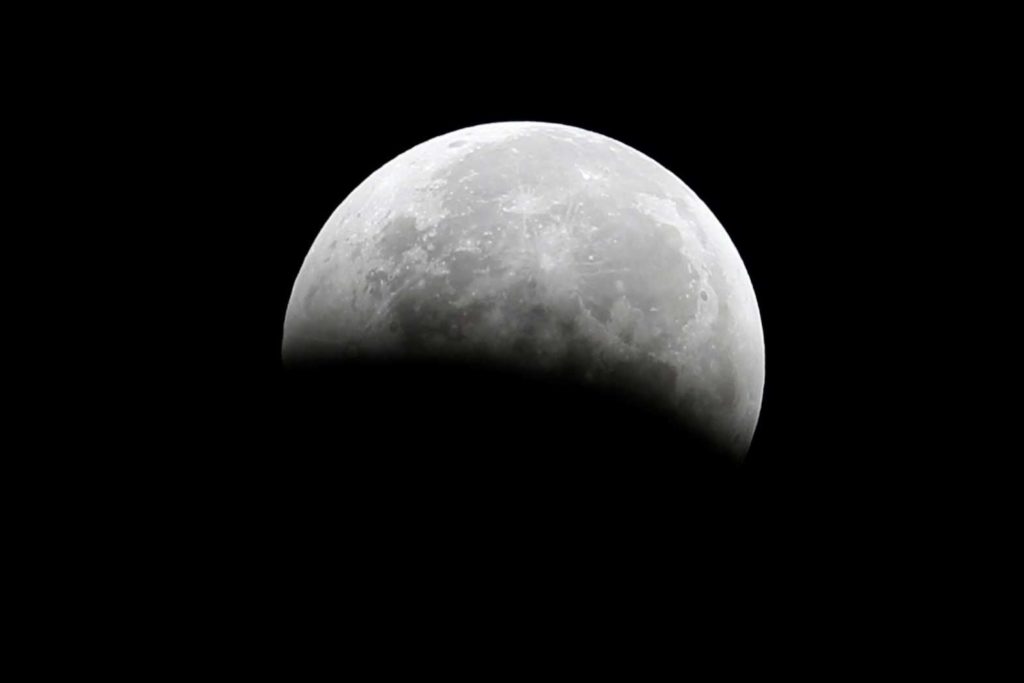Moon has water molecules

x A total lunar eclipse, also known as a “blood moon”, is pictured from Santa Monica, California October 8, 2014. REUTERS/Lucy Nicholson/File Photo
WASHINGTON – The moon lacks the bodies of liquid water that are a hallmark of Earth but scientists said on Monday lunar water is more widespread than previously known, with water molecules trapped within mineral grains on the surface and more water perhaps hidden in ice patches residing in permanent shadows.
While research 11 years ago indicated water was relatively widespread in small amounts on the moon, a team of scientists is now reporting the first unambiguous detection of water molecules on the lunar surface. At the same time, another team is reporting that the moon possesses roughly 15,000 square miles (40,000 square kilometers) of permanent shadows that potentially could harbor hidden pockets of water in the form of ice.
Water is a precious resource and a relatively plentiful lunar presence could prove important to future astronaut and robotic missions seeking to extract and utilize water for purposes such as a drinking supply or a fuel ingredient.
A team led by Casey Honniball of NASA’s Goddard Space Flight Center in Maryland detected molecular water on the lunar surface, trapped within natural glasses or between debris grains. Previous observations have suffered from ambiguity between water and its molecular cousin hydroxyl, but the new detection used a method that yielded unambiguous findings.
The only way for this water to survive on the sunlit lunar surfaces where it was observed was to be embedded within mineral grains, protecting it from the frigid and foreboding environment. The researchers used data from the SOFIA airborne observatory, a Boeing 747SP aircraft modified to carry a telescope.
“A lot of people think that the detection I’ve made is water ice, which is not true. It’s just the water molecules – because they’re so spread out they don’t interact with each other to form water ice or even liquid water,” Honniball said.
The second study, also published in the journal Nature Astronomy, focused upon so-called cold traps on the moon, regions of its surface that exist in a state of perpetual darkness where temperatures are below about negative 260 degrees Fahrenheit (negative 163 degrees Celsius). That is cold enough that frozen water can remain stable for billions of years.
Using data from NASA’s Lunar Reconnaissance Orbiter spacecraft, researchers led by planetary scientist Paul Hayne of the University of Colorado, Boulder detected what may be tens of billions of small shadows, many no bigger than a small coin. Most are located in the polar regions.
“Our research shows that a multitude of previously unknown regions of the moon could harbor water ice,” Hayne said. “Our results suggest that water could be much more widespread in the moon’s polar regions than previously thought, making it easier to access, extract and analyze.”
NASA is planning a return of astronauts to the moon, a mission envisioned as paving the way for a later journey carrying a crew to Mars. Accessible sources where water can be harvested on the moon would beneficial to those endeavors.
“Water is not just constrained to the polar region. It’s more spread out than we thought it was,” Honniball said.
Another mystery that remains unsolved is the source of the lunar water.
“The origin of water on the moon is one of the big-picture questions we are trying to answer through this and other research,” Hayne said. “Currently, the major contenders are comets, asteroids or small interplanetary dust particles, the solar wind, and the moon itself through outgassing from volcanic eruptions.”
Earth is a wet world, with vast salty oceans, large freshwater lakes and ice caps that serve as water reservoirs.
“As our closest planetary companion, understanding the origins of water on the moon can also shed light on the origins of Earth’s water – still an open question in planetary science,” Hayne added.

